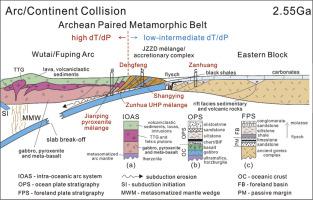当前位置:
X-MOL 学术
›
Earth Sci. Rev.
›
论文详情
Our official English website, www.x-mol.net, welcomes your feedback! (Note: you will need to create a separate account there.)
Mélanges through time: Life cycle of the world's largest Archean mélange compared with Mesozoic and Paleozoic subduction-accretion-collision mélanges
Earth-Science Reviews ( IF 12.1 ) Pub Date : 2020-10-01 , DOI: 10.1016/j.earscirev.2020.103303 Timothy Kusky , Junpeng Wang , Lu Wang , Bo Huang , Wenbin Ning , Dong Fu , Hongtao Peng , Hao Deng , Ali Polat , Yating Zhong , Guanzhong Shi
Earth-Science Reviews ( IF 12.1 ) Pub Date : 2020-10-01 , DOI: 10.1016/j.earscirev.2020.103303 Timothy Kusky , Junpeng Wang , Lu Wang , Bo Huang , Wenbin Ning , Dong Fu , Hongtao Peng , Hao Deng , Ali Polat , Yating Zhong , Guanzhong Shi

|
Abstract Melanges represent a significant component of collisional and accretionary orogenic belts. We present a comparison of subduction-accretion melanges of different ages to test how melange-forming processes at convergent margins changed through time. We describe the Mesozoic McHugh melange in Alaska, and the Paleozoic Proto-Tethyan Laohushan melange of the Qilian Orogenic Belt of the Alpine-Himalayan chain, together with documentation of a Neoarchean melange that marks the suture between the Eastern Block and Central Orogenic Belt of the North China Craton (NCC). The McHugh is a classic accretionary melange that has not yet experienced a collision, and the Laohushan is an accretionary/collisional melange with structures related to both stages of its evolution. We compare the characteristics of these melanges with the world's largest Archean melange, the newly-documented circa 2.5 Ga 1600 km long Jianping-Zunhua-Zanhuang-Dengfeng (JZZD) melange of the North China Craton. The JZZD is a classical melange in terms of map patterns, lithological relations, structural characteristics, including mixed rock types of different ages, origins, and metamorphic histories, and preserves both paired metamorphic features and local blocks preserving ultra-high pressure (UHP) assemblages. It shows high stratal disruption, with both block-in-matrix, and highly-mixed thrust-bounded tectonic slices types of map patterns. The melange is part of an arc/accretionary complex that was emplaced over a 2.7–2.5 Ga passive margin sequence on the western edge of the Eastern Block of the NCC at 2.5 Ga. The frontal zone of the accretionary complex marks the suture between the Eastern Block and an oceanic arc terrane in the Central Orogenic Belt (COB), and exhibits significant along-strike N-S variations. In the north the Jianping pyroxenite melange contains blocks of 2.52 Ga metapyroxenite, metabasalt, tonalite-trondhjemite-granodiorite-diorite (TTGD) gneisses, in a metasedimentary and serpentinite matrix, intruded by 2.49–2.47 Ga plutons, metamorphosed to amphibolite-granulite conditions at 2.47 Ga. The Zunhua/Shangying ophiolitic melange contains relatively intact 2.5 Ga ophiolitic sheets in a 2.5 Ga metasedimentary melange, intruded by 2.48 Ga granitic dikes. The Zunhua ultra-high pressure (UHP) podiform chromite melange has blocks of pillow basalt, BIF, dikes, gabbros, pyroxenite, harzburgite, some with 2.55 Ga podiform chromites in dunite envelopes, enclosed in a 2.52–2.46 Ga metasedimentary matrix, metamorphosed and intruded by granitic dikes at 2.46 Ga. The chromites and dunite pods formed through reaction of a boninitic melt and harzburgite during subduction initiation bewtween 2.6–2.55 Ga. UHP conditions are documented by TiO2 II inclusions in chromites, indicating subduction to at least 270 km depth. The Zanhuang melange includes blocks of metapsammites, metagabbros, metabasalts, and ultramafic rocks in a metapelitic matrix, intruded by 2.49–2.54 Ga granites, then imbricated with >2.65 Ga marble-metapelite-quartzite of the passive margin of the Eastern Block. The Dengfeng melange includes upper-plate blocks of metagabbro, metabasalt, BIF, and felsic rocks in a sandy to pelitic matrix, thrust over a turbiditic broken-formation melange unit in the east. Circa 2.5 Ga metamorphic conditions record a relatively high T/P anatexis (>950 °C/GPa) in the west, whereas the central part of the belt records intermediate T/P metamorphism (
中文翻译:

混杂物随时间变化:与中生代和古生代俯冲-吸积-碰撞混杂物相比,世界上最大太古代混杂物的生命周期
摘要 混杂岩是碰撞和增生造山带的重要组成部分。我们比较了不同年龄的俯冲-增生混杂物,以测试会聚边缘的混杂物形成过程如何随时间变化。我们描述了阿拉斯加的中生代 McHugh 混杂岩和高山-喜马拉雅链祁连造山带的古生代原始特提斯老虎山混杂岩,以及新太古代混杂岩的记载,该混杂岩标志着东部地块和中部造山带之间的缝合线。华北克拉通 (NCC)。McHugh 是典型的尚未经历碰撞的增生混杂岩,老虎山是增生/碰撞混杂岩,其结构与其演化的两个阶段都相关。我们将这些混合物的特征与世界进行比较” 最大的太古代混杂岩,新记录的约 2.5 Ga 长 1600 公里的华北克拉通建平-遵化-赞皇-登封 (JZZD) 混杂岩。JZZD在图谱、岩性关系、构造特征等方面为经典混杂岩,包括不同时代、不同成因和变质历史的混合岩类型,既有成对变质特征,也有局部地块保存超高压组合. 它显示了高度的地层破坏,具有矩阵中的块和高度混合的推力边界构造切片类型的地图模式。混杂岩是弧/增生复合体的一部分,位于 NCC 东部地块西部边缘 2.5 Ga 的 2.7-2.5 Ga 被动边缘序列上。增生杂岩的锋面标志着东部地块与中央造山带(COB)中的大洋弧地体之间的缝合线,并表现出显着的沿走向 NS 变化。在北部,建平辉石混杂岩包含 2.52 Ga 偏辉石、变玄武岩、闪长岩-长闪长岩-花岗闪长岩-闪长岩 (TTGD) 片麻岩,在变沉积和蛇纹岩基质中,被 2.49-2.47 Ga 碎屑岩-变质岩-闪长岩条件侵入2.47 Ga. 遵化/上营蛇绿混杂岩在 2.5 Ga 变沉积混杂岩中含有相对完整的 2.5 Ga 蛇绿岩片,并被 2.48 Ga 花岗岩岩脉侵入。遵化超高压(UHP)豆状铬铁矿混杂岩块状玄武岩、BIF、脉、辉长岩、辉石、菱镁矿,部分含2。55 Ga 豆状铬铁矿被包裹在 2.52-2.46 Ga 变质沉积基质中,在 2.46 Ga 处被花岗岩岩脉变质和侵入。在 Ga-25525252 之间俯冲开始过程中,通过 boninitic 熔体和菱镁矿的反应形成铬铁矿和纯晶荚。 . 超高压条件由铬铁矿中的二氧化钛夹杂物记录,表明俯冲到至少 270 公里深度。赞黄混杂岩在变泥质基质中包括变砂岩、变辉长岩、变玄武岩和超基性岩块,被 2.49-2.54 Ga 花岗岩侵入,然后与东部地块被动边缘的 >2.65 Ga 大理岩-变泥质岩-石英叠瓦。登封混杂岩包括变长岩、变玄武岩、BIF 和长英质岩的上板块块体,位于砂质至泥质基质中,推覆在东部一个浊流破碎地层混杂单元上。大约 2.5 Ga 变质条件在西部记录了相对较高的 T/P anatexis (>950 °C/GPa),而带的中心部分记录了中间 T/P 变质(
更新日期:2020-10-01
中文翻译:

混杂物随时间变化:与中生代和古生代俯冲-吸积-碰撞混杂物相比,世界上最大太古代混杂物的生命周期
摘要 混杂岩是碰撞和增生造山带的重要组成部分。我们比较了不同年龄的俯冲-增生混杂物,以测试会聚边缘的混杂物形成过程如何随时间变化。我们描述了阿拉斯加的中生代 McHugh 混杂岩和高山-喜马拉雅链祁连造山带的古生代原始特提斯老虎山混杂岩,以及新太古代混杂岩的记载,该混杂岩标志着东部地块和中部造山带之间的缝合线。华北克拉通 (NCC)。McHugh 是典型的尚未经历碰撞的增生混杂岩,老虎山是增生/碰撞混杂岩,其结构与其演化的两个阶段都相关。我们将这些混合物的特征与世界进行比较” 最大的太古代混杂岩,新记录的约 2.5 Ga 长 1600 公里的华北克拉通建平-遵化-赞皇-登封 (JZZD) 混杂岩。JZZD在图谱、岩性关系、构造特征等方面为经典混杂岩,包括不同时代、不同成因和变质历史的混合岩类型,既有成对变质特征,也有局部地块保存超高压组合. 它显示了高度的地层破坏,具有矩阵中的块和高度混合的推力边界构造切片类型的地图模式。混杂岩是弧/增生复合体的一部分,位于 NCC 东部地块西部边缘 2.5 Ga 的 2.7-2.5 Ga 被动边缘序列上。增生杂岩的锋面标志着东部地块与中央造山带(COB)中的大洋弧地体之间的缝合线,并表现出显着的沿走向 NS 变化。在北部,建平辉石混杂岩包含 2.52 Ga 偏辉石、变玄武岩、闪长岩-长闪长岩-花岗闪长岩-闪长岩 (TTGD) 片麻岩,在变沉积和蛇纹岩基质中,被 2.49-2.47 Ga 碎屑岩-变质岩-闪长岩条件侵入2.47 Ga. 遵化/上营蛇绿混杂岩在 2.5 Ga 变沉积混杂岩中含有相对完整的 2.5 Ga 蛇绿岩片,并被 2.48 Ga 花岗岩岩脉侵入。遵化超高压(UHP)豆状铬铁矿混杂岩块状玄武岩、BIF、脉、辉长岩、辉石、菱镁矿,部分含2。55 Ga 豆状铬铁矿被包裹在 2.52-2.46 Ga 变质沉积基质中,在 2.46 Ga 处被花岗岩岩脉变质和侵入。在 Ga-25525252 之间俯冲开始过程中,通过 boninitic 熔体和菱镁矿的反应形成铬铁矿和纯晶荚。 . 超高压条件由铬铁矿中的二氧化钛夹杂物记录,表明俯冲到至少 270 公里深度。赞黄混杂岩在变泥质基质中包括变砂岩、变辉长岩、变玄武岩和超基性岩块,被 2.49-2.54 Ga 花岗岩侵入,然后与东部地块被动边缘的 >2.65 Ga 大理岩-变泥质岩-石英叠瓦。登封混杂岩包括变长岩、变玄武岩、BIF 和长英质岩的上板块块体,位于砂质至泥质基质中,推覆在东部一个浊流破碎地层混杂单元上。大约 2.5 Ga 变质条件在西部记录了相对较高的 T/P anatexis (>950 °C/GPa),而带的中心部分记录了中间 T/P 变质(



























 京公网安备 11010802027423号
京公网安备 11010802027423号